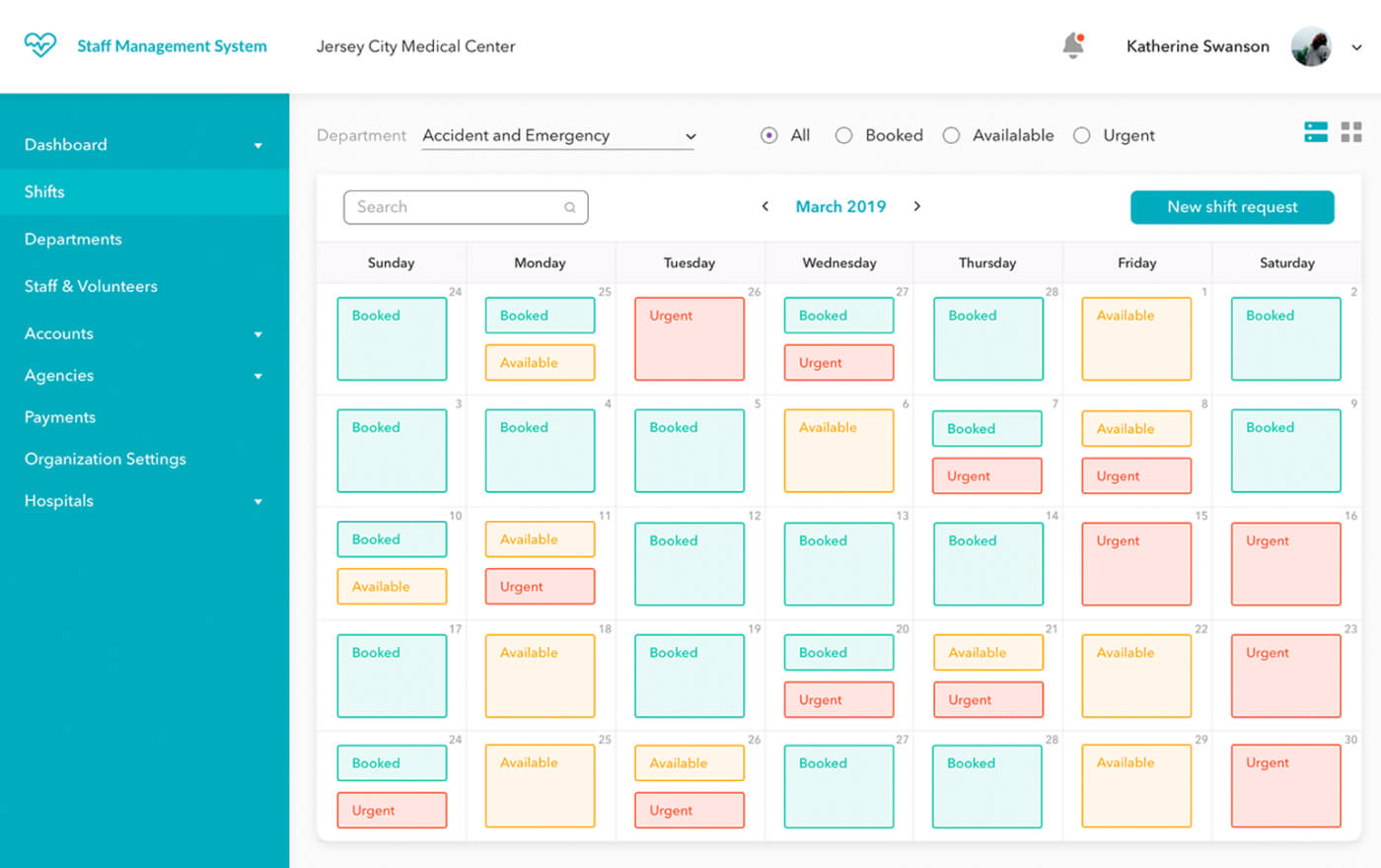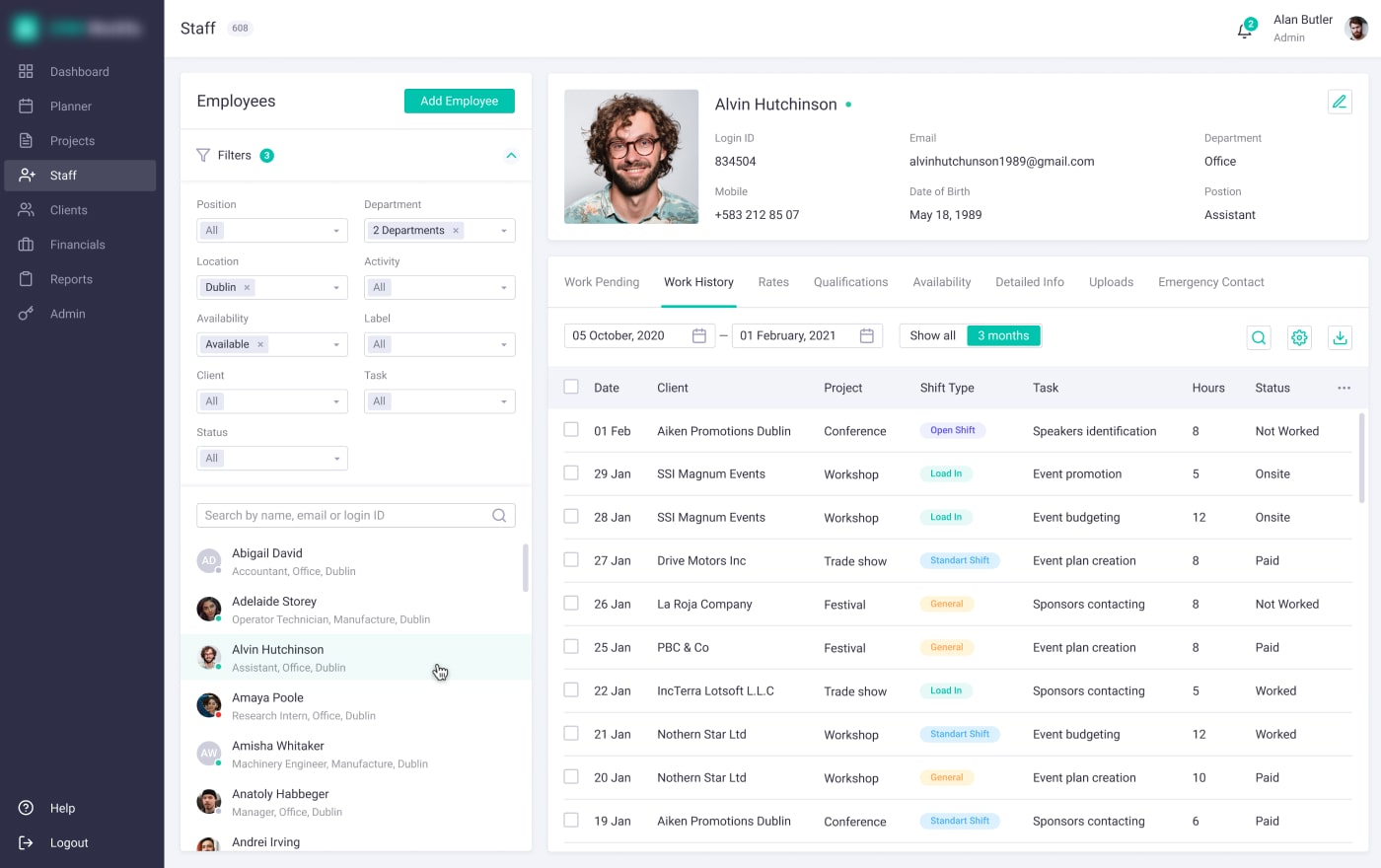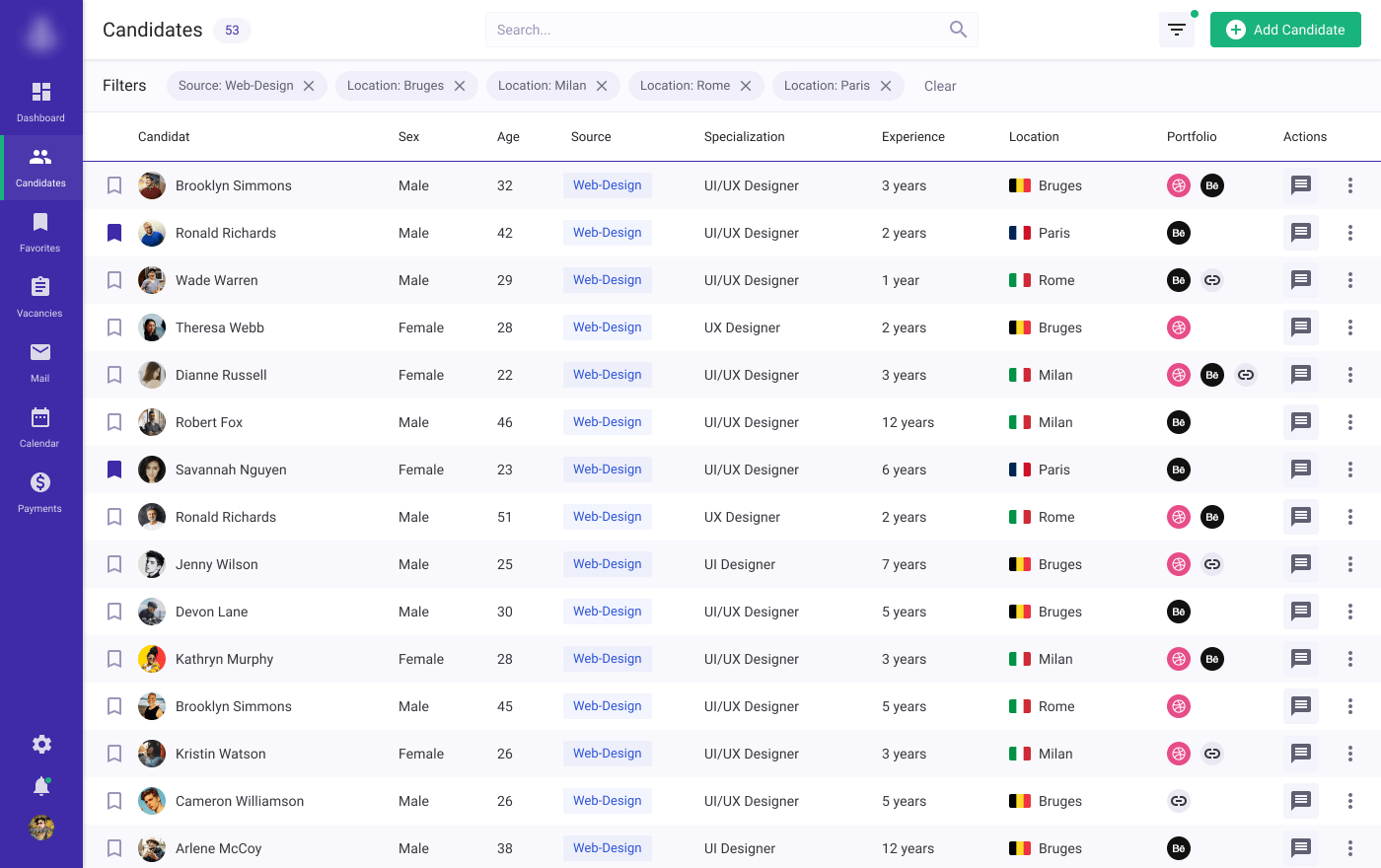Summary
Staffing firms waste valuable time due to manual scheduling, fragmented tools, and reactive planning. This article highlights five common time-sinks—like shift chaos, document juggling, and poor client communication—and shows how custom project management software with features like drag-and-drop scheduling, integrated ATS, compliance workflows, and real-time dashboards can streamline operations and boost placement outcomes.
The staffing industry has always been fast-paced. Clients want quick turnarounds. Candidates expect instant responses. Compliance rules shift constantly. And staffing specialists? They’re caught in the middle, trying to juggle endless tasks while still building meaningful connections.
5 Factors That Decline Staffing Efficiency
Here’s the hard truth: recruiters and account managers in staffing firms don’t just lose time because of high workloads — they lose it because their processes aren’t built for the reality of modern business. Many staffing specialists still rely on spreadsheets, disconnected tools, or one-size-fits-all project management software that doesn’t reflect staffing-specific workflows. As a result, hours lost, opportunities missed, and clients left waiting.
However, the right custom project management software can turn wasted time into smarter workflows, stronger customer relationships, and more placements. Let’s break down the 5 biggest time-wasters we see in staffing firms, and how modern staffing software solutions fix them.
Time-Waster #1. Manual Scheduling and Shift Management in Staffing Firms
Recruiters spend hours every week matching candidates to shifts, manually entering availability, and updating spreadsheets whenever someone cancels. In industries like healthcare, hospitality, or construction, last-minute no-shows can throw entire schedules into chaos.
For example, when two electricians call in sick, the recruiter has to dig through spreadsheets, call around to check availability, and reassign shifts by hand. By the time replacements are found, the concrete team is already waiting idle on-site — delaying the whole project and increasing labor costs.
Every hour spent on scheduling is an hour not spent building relationships, sourcing candidates, or closing deals. Plus, manual updates increase the risk of double-bookings, frustrated candidates, and unhappy clients.
Which type of project management software can be used in this case?
Here’s an example of how we helped one of our clients, a medical institution that struggled with manual work. To avoid shortage of medical staff, especially during unexpected emergencies like natural disasters, or even small delays, they wanted a project management system that could automate employee scheduling and shift planning. The system should also include the scheduling and planning of the shifts for volunteers, as well as the possibility to check their availability.
That is why a custom project management system for staffing was developed. Scheduling was integrated with candidate databases, so the staffing managers can see who’s available in real time, assign shifts in a drag-and-drop interface, and push instant updates to employees and volunteers via mobile app or notifications.

As a result:
- the Staff Management and Notification System for Medical Institutions helped medical managers to streamline operations by easily creating schedules, assigning tasks, and monitoring volunteer availability;
- staff and volunteers, on the other hand, could be able to stay connected through instant alerts sent by email, SMS, or mobile app — with the ability to respond right away.
Time-Waster #2. Chasing Documents and Compliance Paperwork in Recruitment
In staffing, paperwork is everywhere. Recruiters juggle employment contracts, onboarding forms, tax documents, NDAs, background checks, and professional certifications — often for dozens or even hundreds of candidates at once. They waste hours hunting for missing files, double-checking versions, or chasing candidates to re-send documents that were lost in the shuffle. That’s valuable time that could be spent actually sourcing and matching talent instead of playing detective with PDFs.
The problem doesn’t stop at inefficiency — it’s also a compliance risk. Staffing firms are trusted to supply fully vetted, legally compliant professionals. One expired certification or missing background check can expose an agency to fines, failed audits, broken trust with partners, and even terminated contracts.
Which type of project management software can be used in this case?
A custom recruitment management system can help with that, and we have a perfect example to share. One of our clients from a staffing firm wanted to improve not only staff scheduling and shifts planning, but they also needed to make the recruitment and reporting processes more effective. The business owner required a powerful but simple scheduling system that offered drag-and-drop planning, reusable templates, and advanced search tools.
Beyond scheduling, the staffing workflow automation app had to strengthen team collaboration with reliable communication features and streamline recruitment by automating repetitive tasks like setting up interview appointments.

As a result:
- the Automated Workforce Management and Scheduling System removed chaos by centralizing document management, automating compliance checks, and streamlining processes;
- group emails, staff portal, holiday requests, and other implemented features improved communication and mutual understanding within the company by allowing clients to securely view compliance records and implementing automated reminders that notify recruiters and candidates;
- this project management platform also automated workforce management activities, simplified communication between managers and workers, and helped to achieve faster billing and payroll.
Time-Waster #3. Poor Communication Between Recruiters and Clients
How many times have you received an email “Can you send me an update?” and the answer was lost in piles of files and contacts scattered among different systems? Without a structured system, recruiters manually compile reports, dig through email threads, and send updates piecemeal. Multiply this across dozens of requests, and you’ve got hours wasted on reactive communication.
Clients expect transparency. When they don’t get it, they start doubting whether the agency is really on top of things. Poor communication doesn’t just waste time — it can cost you renewals.
Which type of project management software can be used in this case?
The most effective choice in this situation would be a client collaboration–focused project management system (CRM-integrated PM tool). Here’s how it can help:
- Shared Dashboards & Portals: Instead of customers emailing for updates, they can log into a portal that shows candidate pipelines, placements, or progress in real time.
- Automated Reporting: Recruiters don’t have to manually compile reports, the system auto-generates summaries and sends scheduled updates.
- Centralized Communication: All messages, recruiter notes, and candidate details stay in one platform, not spread across inboxes and spreadsheets.
- Transparency & Trust: Clients see exactly where things stand, reducing back-and-forth and strengthening long-term relationships.
So in this case, the solution would be a project management platform with built-in client communication and reporting features (like custom dashboards, portals, and automated status updates).
Time-Waster #4. Tool Overload and Data Silos in Recruitment Software
Staffing firms often juggle multiple tools — an ATS, payroll software, a scheduling app, maybe even a generic project management tool. However, the problem is that none of them are connected to each other. Recruiters spend hours copy-pasting data between systems or dealing with errors caused by inconsistent records.
Disconnected tools mean wasted time, higher error rates, and frustrated recruiters. A single misplaced entry can snowball into payroll mistakes or scheduling conflicts.
Which type of project management software can be used in this case?
To deal with this issue, the most effective choice would be an all-in-one project and workforce management platform (ATS + PM hybrid). Here’s how it will help:
- Integrated Modules: Instead of juggling separate tools for Applicant Tracking System (ATS), payroll, scheduling, and reporting, everything runs on one system with a shared database;
- Error Reduction: With centralized data, recruiters don’t need to copy-paste between apps, which means fewer payroll mistakes and scheduling conflicts;
- Seamless Workflows: Candidate records, job orders, time sheets, and payroll info automatically flow across modules without manual intervention;
- Unified Dashboards: Managers and recruiters see real-time staffing, compliance, and financial data in one place.
So in this case, the solution would be a project management platform with ATS, payroll, scheduling, and reporting fully integrated into a single ecosystem, eliminating silos and saving recruiters hours of repetitive work.
Read Also Deep Dive Into the Job Application Process Through the Applicant Tracking System (ATS)
Time-Waster #5. Reactive Firefighting Instead of Proactive Resource Planning
Staffing firms often find themselves scrambling at the last minute to cover requests: a client needs 10 IT specialists for a project tomorrow, a candidate cancels at the last minute, or a deadline is missed. Recruiters rush to call candidates, update schedules, and fill roles, often working late to patch holes. Without visibility into workforce availability or upcoming demand, managers are trapped in reactive mode.
And always reacting means never improving. Eventually, a staffing firm obtains stress for recruiters, poor candidate experience, missed deadlines, and clients who lose trust when shifts can’t be covered on time. Instead of strategic planning, staffing teams live in constant firefighting mode.
Which type of project management software can be used in this case?
Effective resource forecasting is vital for any business, and we have a real-life example of a candidate management system that helped with this issue. One of our clients in a staffing context needed more than just a basic scheduling system — they needed a tool that allowed them to act proactively, forecast workforce demand, and coordinate with precision. Rather than reactive patchwork, the solution was a unified human resource management system equipped for dynamic planning.

As a result:
- a web-based human resource management platform allowed real-time visibility into candidate availability and open shifts, making it easy to allocate resources before crises emerge;
- intuitive, fast workflows consistent across desktop and mobile ensured that recruiters could quickly fill last-minute requests, even on the go;
- employers and candidates became connected seamlessly within the same interface by job posts, CV uploads, messaging, and direct payments to streamline communication and reduce coordination delays;
- smart automation (like instant job alerts, candidate matching, and one-click shift confirmations) helped staffing managers shift from scrambling to proactive coverage.
Who Can Benefit from Staffing Project Management Software
While any staffing agency deals with the same challenges (shifting client needs, candidate pipelines, and high volumes of communication) not every business operates at the same scale. The good news is that project management software adapts to different sizes and models of staffing firms and allows the development of diverse project management tools for staffing agencies.
Small and Mid-Sized Staffing Agencies
Smaller teams often wear multiple hats, handling recruitment, client communication, and reporting all at once. A centralized staffing system prevents duplicate work, ensures no lead slips through the cracks, and helps growing firms punch above their weight without hiring extra coordinators.
Large Enterprise Staffing Firms
With hundreds of recruiters and multiple locations, large staffing companies juggle high candidate volume and complex client requirements. Custom project management software creates a unified structure, standardizes workflows across branches, and ensures real-time visibility into performance.
Niche and Specialized Recruiters
Agencies focusing on healthcare or executive search and IT staffing agencies rely on speed and precision. Project management software helps track specialized talent pools, manage compliance-heavy documentation, and keep client deliverables transparent.
Internal HR and Corporate Talent Teams
It’s not only staffing agencies that benefit. In-house HR and staffing departments can use custom tools to streamline hiring requests, track applicants, and manage approvals, making internal recruitment processes faster and less error-prone.
Remote and Hybrid Staffing Teams
With more recruiters working remotely, distributed teams need real-time access to the same data. Custom project management software enables collaboration without endless email threads, making sure client and candidate updates are always up to date.
At the end of the day, if your staffing team spends too much time coordinating instead of actually staffing, project management software is where you get your time back.
Popular Project Management Systems for Staffing (and a Glimpse into 2030)
Some staffing agencies today still rely on popular project management platforms to streamline recruiting, candidate tracking, and client management. Some of the most widely used solutions include:
- Bullhorn – Enterprise-grade staffing platform with strong automation and CRM capabilities;
- Zoho Recruit – Flexible recruiting solution with automation features and integrations;
- Workable – User-friendly platform for posting jobs, tracking applicants, and team collaboration;
- Crelate – Focused on recruiters, offering candidate and client management with simplicity;
- iCIMS – Corporate recruiting platform covering hiring, onboarding, and integration.
Looking ahead to 2030, the list may shift drastically and more and more businesses may turn to custom software solutions as they are able to cover more unique needs of staffing teams and can include:
- AI-driven Talent Insights: Predictive analytics for recruitment and AI in staffing software will identify the right candidates faster, optimize resource allocation, and automate repetitive tasks;
- Virtual and Augmented Reality Assessments: VR/AR simulations may allow candidates to demonstrate skills in realistic scenarios before hiring decisions;
- Global Remote Collaboration: Platforms will increasingly support fully remote, cross-border staffing, enabling agencies to tap talent worldwide.
By 2030, staffing project management systems are expected to evolve from tools for managing processes to intelligent platforms that help agencies sell outcomes, not just fill roles.
Final Thoughts: Why Custom Project Management Software Is a Game-Changer for Staffing
Staffing isn’t like marketing, sales, or construction — it has its own unique workflows, from compliance-heavy onboarding to client transparency needs. Generic project management tools can’t handle that complexity, while custom-built solutions give staffing firms:
- A single source of truth for candidates, clients, and recruiters;
- Faster placements and reduced administrative overhead;
- Real-time collaboration with clients;
- Tools that scale as the agency grows.
In a market where speed and client experience are everything, the firms that streamline workflows are the ones that win. So if you want to become an effective leader, contact us to develop staffing software that will suit your business.